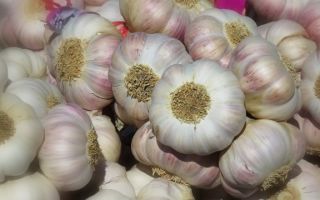Garlic is a biennial plant, does not produce seeds, and reproduces only by vegetative means.
Content
Description and composition
Garlic has been cultivated for over 5 thousand years, and its healing properties were known to the ancient Egyptians.
Avicenna briefly described garlic - “For all diseases.” Research has shown that it is difficult to find an organ on which it does not have a beneficial effect, and there are few diseases for which it does not help.
Garlic contains the following beneficial substances:
- vitamins B1, B2, B3, B6, C and D,
- biotin,
- folic acid,
- germanium,
- iron,
- iodine,
- potassium,
- calcium,
- magnesium,
- manganese,
- selenium,
- phosphorus,
- zinc,
- cellulose.
The taste of garlic is due to the presence of essential oil, which is in bound form in the form of aniline glycoside. When it is enzymatically broken down, essential oil and fructose are formed. The intermediate product is allicin, which gives garlic its specific smell.
Properties used in treatment
Garlic has a pronounced antibacterial effect, stimulates appetite, enhances the secretion of digestive enzymes and bile, promotes better absorption of food, and has a strong anthelmintic , analgesic and calming effect on the intestines.
Diseases
Modern research has shown that garlic preparations
- increase secretion and motor function of the intestines ( constipation ),
- kill candidiasis pathogens ,
- tuberculosis,
- staphylococci,
- lower blood pressure,
- increase the amplitude and slow down the heart rate,
- dilate peripheral and coronary vessels of the heart,
- increase urine output.
Allahol tablets, produced by the pharmaceutical industry, containing dry garlic extract, are used as a laxative for chronic constipation, and are used as a choleretic agent for chronic hepatitis, cholangitis, and cholecystitis.
Garlic tincture is recommended to suppress the processes of fermentation and putrefaction in the intestines; it is prescribed for intestinal atony and colitis , as well as for hypertension and atherosclerosis.
In the form of aerosols, garlic phytoncides are used for bronchial asthma and bronchitis.
Fresh gruel and juice are used to treat warts, lichens, eczema and other skin diseases.
Studies by epidemiologists have shown that those peoples who eat a lot of garlic have a lower incidence of cancer than peoples who do not consume it. The sulfur compounds contained in garlic, in particular allicin and diallyl sulfide, protect cells from mutations caused by carcinogens. Other anti-carcinogenic components of garlic include the powerful antioxidant minerals germanium and selenium.
Methods of application
Garlic tincture is used to expel worms
- Peel five medium-sized heads of garlic, mash well into a paste and pour in 500 ml of vodka;
- leave for a week at room temperature, then strain out the mashed garlic, squeezing the pulp vigorously;
- store the tincture, tightly corked, in a cool place;
- take 30 drops for 3-4 days on an empty stomach, half an hour before meals;
- on the days of taking garlic tincture, you must take a laxative (not an oil laxative);
- The smell of garlic tincture can be dispelled by chewing parsley.
Taking the tincture is contraindicated for nephritis and angina.
Garlic infused olive oil:
add 8 cloves of garlic and 1 teaspoon of chopped chili to a 250 ml bottle of olive oil; before doing this, you can pour some of the oil so that it does not spill out; close tightly and place in a cool, dark place for several days; then use it as a salad dressing.
Youth elixir:
Grind 350 grams of garlic, add the juice of 24 lemons; Place the mixture in a wide-necked jar, tie with gauze, leave for 24 hours; Every day before going to bed, drink half a glass of water with 1 teaspoon of the mixture diluted in it; Shake the mixture in the jar before use.







